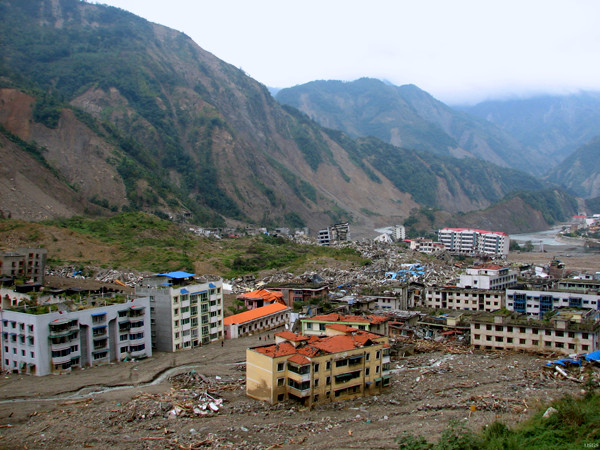
by Timothy Oleson Thursday, May 15, 2014

Credit: David Wald, USGS
In May 2008, a magnitude-7.9 earthquake struck near Wenchuan, China, killing more than 80,000 people in the country’s biggest quake since 1950. Then, in April 2013, the magnitude-6.6 Lushan earthquake hit just 90 kilometers to the south — also within China’s Longmenshan Fault Zone, which separates the Tibetan Plateau to the west from the Sichuan Basin to the east — and caused another 200 deaths. Now, scientists have found that a roughly 60-kilometer segment of the fault zone between the epicenters of the two big temblors could be the next to rupture, although no one knows when or how big it might be.
The two major earthquakes, occurring just five years apart, have raised many questions among seismologists about the geological setting where they occurred, about possible connections between the two quakes and about the ongoing seismic hazard in the vicinity. These questions were the subject of eight new studies — published together in a recent issue of Seismological Research Letters — that examined the circumstances of the more recent Lushan earthquake and sought to put the two quakes into context.
Several of the papers detail the hypocenter and focal mechanism of the Lushan quake, which occurred at about 12 kilometers depth, and its main aftershocks. Identifying the actual fault on which the quake occurred is difficult because it didn’t rupture all the way to the surface, researchers noted, though one study identifies a subsurface thrust fault as a possible culprit.
Based on statistical analyses of aftershocks and changes in stress loading on surrounding faults following the 2008 Wenchuan earthquake, two papers suggest that the Lushan earthquake was a large delayed aftershock of the earlier quake. And another, which compares the Wenchuan and Lushan quakes to other major earthquake-aftershock sequences such as the 1992 magnitude-7.4 Landers earthquake in California and its aftershocks, suggests that, in hindsight, the location of the Lushan quake could have been predicted based on static stress changes following the Wenchuan. Lastly, the portion of the Longmenshan between the segments that ruptured in 2008 and 2013 is identified in multiple studies as being the most likely to rupture next.
© 2008-2021. All rights reserved. Any copying, redistribution or retransmission of any of the contents of this service without the expressed written permission of the American Geosciences Institute is expressly prohibited. Click here for all copyright requests.